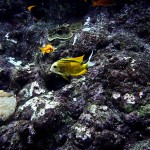What an understatement it is to say that the devastating Japanese tsunami of 2011 constituted a major ecological disturbance. Having lived on the Oregon coast at that time and having seen the massive amounts of debris that littered our shores in its aftermath, I can attest that people there were for a long time recovering items that drifted across the Pacific from Asia. It is at least conceivable that some Asian fish species (whether as juveniles or adults) were able to invade North America via the flotsam and jetsom.
Indeed, five barred knifejaw or striped beakfish (Oplegnathus fasciatus) were discovered in a lost Japanese boat that turned up in Long Beach, Washington in 2013. One of these specimens was turned in to the Seaside Aquarium (where it reportedly continues to thrive to this very day). And now, roughly two years after this first sighting, the species has again been taken from the Northeast Pacific. In this case, a single specimen had been captured in a crab pot by fishermen near Port Orford, Oregon. This animal was successfully transported alive to a holding system under the care of a buyer before being moved to the quarantine facility of the Hatfield Marine Science Center (up in Newport) to be evaluated by Oregon State University aquatic veterinarian Tim Miller-Morgan of Oregon Sea Grant.
Knifejaws are known to drift with oceanic debris. But to have found an individual that may have immigrated only shortly after the event of 2011 is a bit surprising. It might suggest that the species could become established in North American waters. Still, as OSU marine ecologist Jessica Miller points out, there is presently no evidence of any breeding population of knifejaws in Oregon.
Tom Calvanese, the Oregon Sea Grant researcher who first began to work with the fishermen, praised the local fishing community at large for its “ocean-awareness,” being able to spot an exotic species and swiftly return it alive for use by the scientific community.
To read the OSU news release, please visit: http://blogs.oregonstate.edu/breakingwaves.











0 Comments